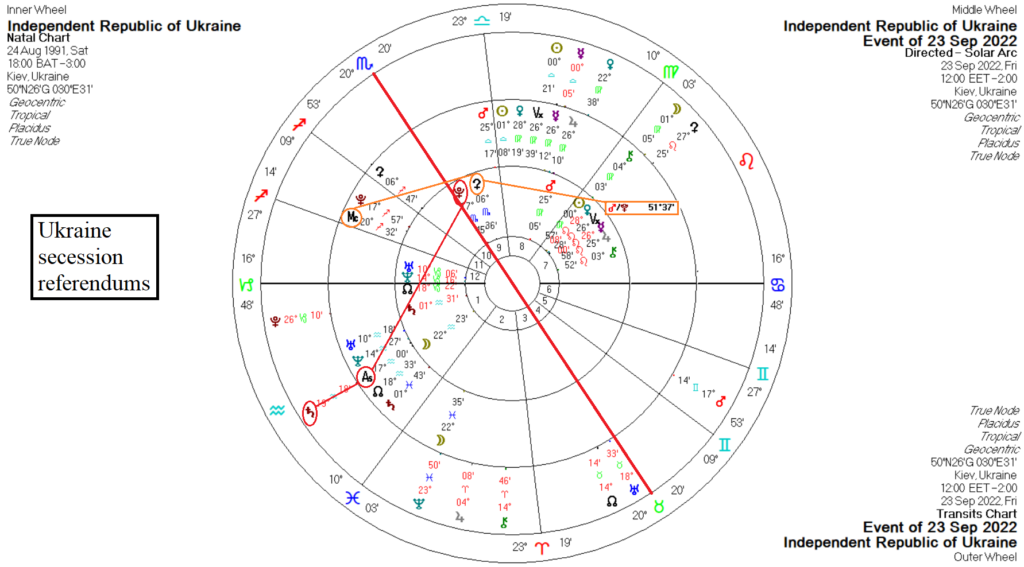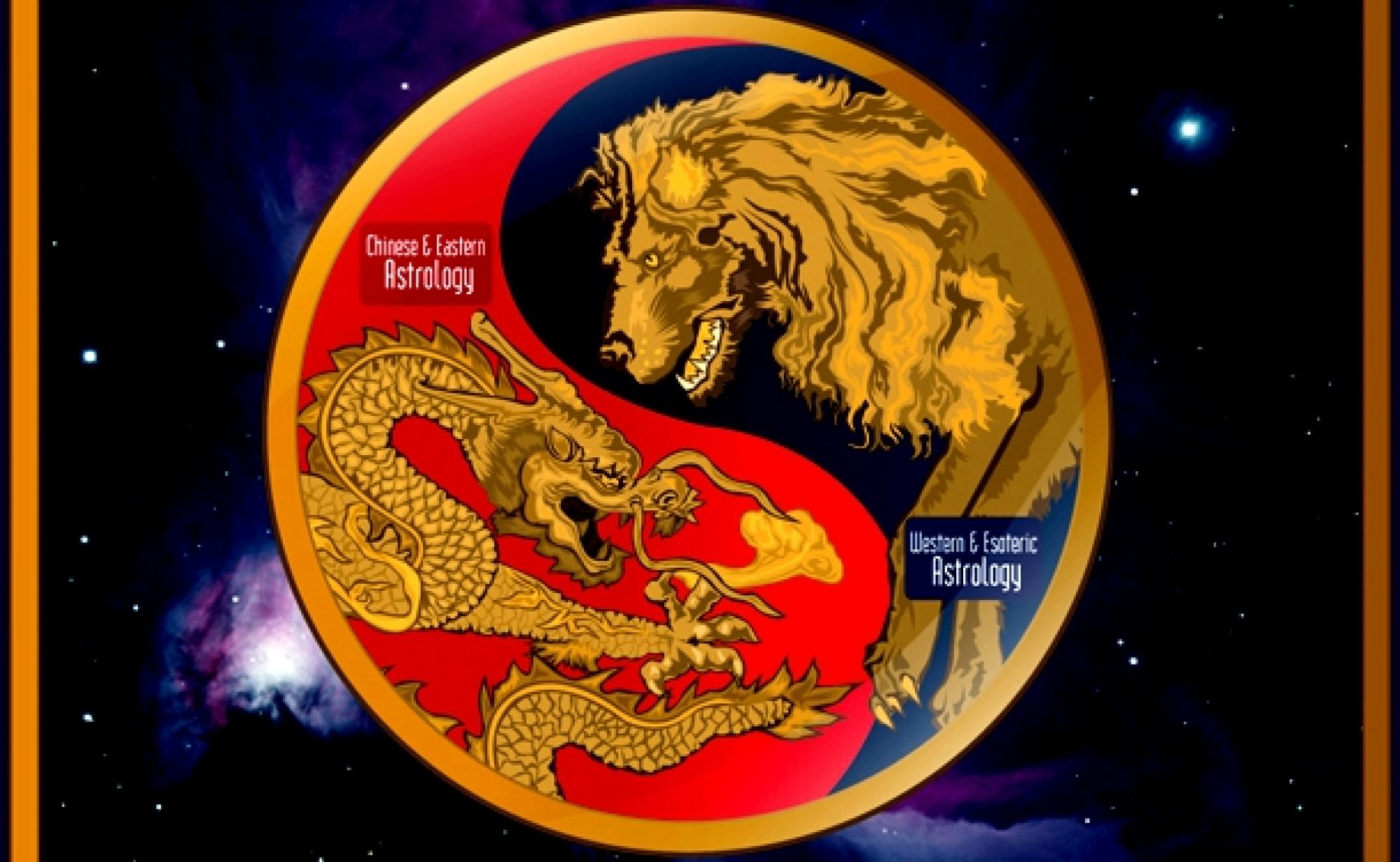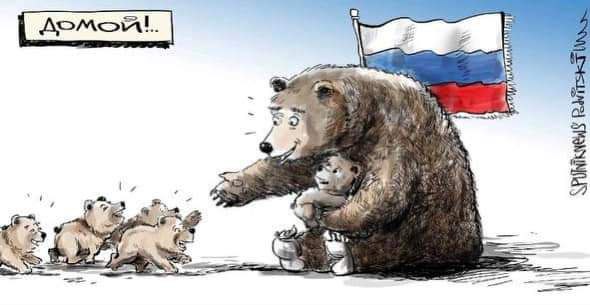“There are decades where nothing happens; and there are weeks where decades happen.” (Vladimir Lenin)
From the Libra equinox to the 27th of September four oblasts in present-day Ukraine voted on whether or not to secede from Ukraine and join the Russian Federation. The result was almost unanimous in all four: Thus starts the breakup of Ukraine. Those regions are now a part of Russia, from 30 September, whether the West accepts it or not. That is how the Russians see the matter now, as closed. Along with that, Russia has just announced a partial mobilization of its reserve forces, to the tune of just over 1%. Apparently and from the propaganda in the Western media proceeding from those events, the Western elites are apoplectic. We will examine all that here, starting with Ukraine’s astrology.
This post follows on from the post on Ukraine’s dark winter. Readers in the West should know that the people of those four regions have looked forward to this day for eight years, having suffered daily shelling and persecution from nationalist Ukrainian forces during those eight years. The current transits and directions to the Ukrainian chart are below (bigger):

What we see is that in mid-October the transits of Saturn and Uranus complete and activate the directed Ascendant to the natal Pluto, yielding the combination, Sat/Ura=Asc/Plu. Asc/Plu is the striving for power, the desire to appear important, the effort to make an impression in the world. It also points to dictatorship in the extreme negative and brutality: “Violent disputes, quarrels, injuries, accidents. A drastic or radical change of one’s circumstances in life,” as well as, “Dictatorship or rule by force. The desire to bring other people under the rule of one’s own will. A repulsive behaviour.”
We see all this type of behavior in the Ukrainian regime at the moment, for a dictatorial regime is what Zelenskyy and Co. has become. They have even said they want to become ‘Big Israel’ – in other words, an apartheid, fascist regime in the heart of Eastern Europe. When activated by a dual transit of two of the ‘heavy hitters’ together, the Plu/Asc combination when negatively expressed becomes like a catastrophe waiting to happen.
Saturn and Uranus in combination indicate ‘out with the old, in with the new’, or a distinct change in the old order. In the positive it indicates renewal and leaving the past behind. In the negative the combination becomes destructive: “the tendency to cause unrest within one’s environment, a quarrel, separation, the use of force, interventions in one’s destiny, the limitation of freedom.”
With all this said, one could argue it is the Russians expressing all of the above, and that is how the Western media is spinning it – Putin is desperate, cornered (making him more dangerous than ever), out of options, his strategy is failing, his threats are empty, mad/crazy (those are old memes), a man who ‘has fallen into the dictator trap’:
“In the span of a couple of weeks [speaking of the start of the Russian SMO], Vladimir Putin—a man recently described by Donald Trump as a strategic “genius”—managed to revitalize NATO, unify a splintered West, turn Ukraine’s little-known president into a global hero, wreck Russia’s economy, and solidify his legacy as a murderous war criminal. How did he miscalculate so badly?”
The trouble is, all the points made in the quote are instead mistaken. NATO has emptied its storehouses of weapons and is greatly weakened as a result. The ongoing conflict is beginning to show the West to be riven by internal divisions, is splintering the West, has taken the sheen off Zelenskyy, who is now more irritating to the public than praised (the elites still sort of like him because he suits their purposes), Russia’s economy is under stress, but is stable and with swelling coffers, and has shown the world outside the West the hypocrisy of calling him a war criminal. Seems Putin is a little smarter than people like to give him credit for. There is a point to all this.
Putin has not done any of this in isolation – neither the mobilization nor the referendums (or referenda if you like. Seems to be a personal choice of the word these days). He does not rule with an iron hand. He may accurately be called an autocrat, or maybe not (I am not in a position to say) He must act in consultation within a vast bureaucracy. As to the mobilization, that went hand-in-hand with the referendums. There is clear reasoning behind both decisions, which we will outline as we go along. The Duma decided it was time to have the referendums in the four oblasts due to urgent requests from the people in the oblasts themselves – the great majority being Russian-speaking, some of them being Russian citizens.
As much as the Western media tries to call these sham referendums and illegal (just don’t mention Kosovo or the Golan Heights), but there were paper ballots, they were monitored by 542 journalists from the DPR, Russia, UK, China, France, Italy, Portugal, Venezuela and Qatar, and that is in the Donetsk republic alone. There were also 129 observers from six countries – Russia, Italy, Venezuela, Romania, Togo and South Africa. The vote was transparent and in order. The DPR sent out invitations for observers and journalists. No matter what happens, the referendums will never be recognized, yeah or nay by the West.
Here is the thing about these referendums: The recent incursion by Ukraine in the Kharkov region sent a wave of panic through the four oblasts. They wanted Russian assurances that Russia has their backs, and the best way to do that, to ensure Russia never leaves, were these referenda, to become part of Russia again. It was time for Russia to put-up-or-shut-up. Culturally, these people are largely Russian. What is not to understand?
Recently Zelenskyy stated that Russian soldiers should leave Ukraine, should run for their lives. The residents of the oblasts, knowing what awaited them if Ukrainian forces were to return, decided to leave, too. So, they did. It’s just not exactly what Zelenskyy and his cohorts (or NATO) had in mind.
However, that brought in another little problem for the Russians should the referendums prove successful – too few troops to secure the areas, the new Russian oblasts, while the SMO continued. Thus, the Russian General Staff (RGS) recommended an extra 300,000 troops to fill the void. Putin signed the order.
This is not the huge, or potentially even escalation the West is making it out to be. It is actually compensating for new territory. It is actually what would be required for military presence on an area of over 100,000 km2 to keep the borders secure. The front (the borders) is over 1000 km in length. Essentially, those troops would go to form a new Russian military district.
And the mobilization is not exactly a wartime footing. Russia has roughly 25 million reservists. If the RGS wanted to mobilize, they could amass a huge army in short order, without the draft. The current active Russian army is numbered at about one million. The 300,000 reservist force is nothing to sneeze at, true, but it is paltry in comparison to what the RGS could really mobilize.
Those major part of the 300,000 troops are unlikely to be sent to the front, either. The soldiers doing the actual fighting up until now are all volunteers – contract/career soldiers. Conscripts (draftees) are not sent to the front, according to Russian military doctrine, though some mistakes have been admitted. Those volunteers are comprised of the Wagner Group (about which little is known), over 10,000 Chechen reservists, the forces of the DPR and LNR (around 44,000), and so on. Like Putin once quipped, the Russians haven’t started anything yet in earnest. To be clear, the partial mobilization is not conscription. It is the partial call-up of reserve soldiers who already have military experience.
As a result of the partial mobilization and secession vote Wisner’s Mighty Wurlitzer has the volume up to 11 and is about to blow a fuse. There are MSM reports of long lines of cars scrambling to leave Russian territory, whereas the border control authorities in the named countries in the Guardian article say there is nothing out of the ordinary (see also here). There were also reports of panic and protests after mobilization was announced. Those were notably small and have died off. About 1,300 people were arrested (the UN cites over 2,300) for those unsanctioned protests, with some of them receiving call-up for military service (drafted, in other words, because they were of age).
As things stand now, 29 Sep, the four oblasts have voted overwhelmingly to go back to Russia, thus depriving Ukraine of most of its valuable real estate and economic capacity. It has added over 5.5 million people to the Russian Federation as well as over 100,000 km2 to Russian territory. France will become the 2nd-biggest country in Europe at that point. The results of the referendums were as follows after all the votes were counted, the percentage voting to return to Russia:
-
- Donetsk: 99.23%
- Lugansk: 98.42%
- Zaporizhzhia: 93.11%
- Kherson: 87.05%
The turnout in those regions was enthusiastic. Coercion was absent. Venessa Beeley and Eva K. Bartlett were there reporting on the ground and everything was calm, the people happy and enthusiastic, despite Western reporting. There was military presence there, but the soldiers were there to safeguard the polling places. While the voting was taking place the Ukrainians were shelling civilian areas in the regions, seeking to disrupt the voting, to no avail, obviously. They even targeted a building where foreign journalists were staying. The EU has threatened foreign observers to the referendums.
The Duma will meet next week on 3 October and the Federation Council on the 4th to vote on the accession. It is expected the regions will become Russian territory at that point. After that events in Ukraine will become very interesting, and intense.
Ukraine may lay claim to those territories, but they have traditionally been Russian provinces, and for at least three centuries. They were attached to Soviet Ukraine in 1922, which then became independent Ukraine in 1991 after the collapse of the Soviet Union. Crimea was never really considered a part of Ukraine. The four regions have traditionally been Russian-speaking and Russian culturally for centuries. Then, there is the Novorossiyan Confederation, which few people really know about, but which would be comprised of the four plus 6 other present Ukrainian oblasts. Those six others may now be looking at what has happened and may be reconsidering their alliances. They were once part of the old Novorossiya.
What can we expect, then? – the SMO to transform into an anti-terrorist campaign, which will not be the slow-paced SMO. Once the Ukrainian forces are pushed out of the new Russian oblasts then those regions will have to be secured against further shelling by Ukraine. It is doubtful the Ukrainians will stop, as the West will want to prolong the war. That would probably entail another invasion of Ukraine.
The Russian public will not stand for the new regions to be attacked. The Russian military will be called upon, with wide public support, to take the battle to the command centers in Kiev and against Ukrainian infrastructure. No longer fighting with one hand behind its back, Ukraine and NATO will see the full force of the Russian military in action. These next weeks mark a very serious and possibly dangerous period.
And if there were to be a further push west, south and north by Russian forces, of the six remaining Ukrainian oblasts of the proposed Novorossiyan Confederation, Nikolaev and Kharkov would be next on the list for ‘denazification and demilitarization’, followed by Odesa and then eventually Dnipropetrovsk, Sumy and Kirovograd, offering those regions to hold referenda as well. The map of Ukraine would then basically reconstitute the historical Novorossiya. Odesa and Kharkov will almost certainly return to Russia eventually as they were two of the regions that most strongly objected to the anti-Russian campaign of post-2014 Kiev. Odesa is particularly marked for ‘de-Nazification due to the massacre that happened there in 2014.
In his speech during the signing ceremonies for accession, Putin read the Western powers the riot act, blasting the ‘neo-colonial West’. He made it clear there would be no negotiations on returning those regions. They are Russian ‘forever’. He added further how any attacks on those new Russian oblasts would be dealt with: “We will protect our land with all the forces and means at our disposal and will do everything to ensure the safe life of our people.” The West may not recognize those regions as Russian, but it would be ill-advized to try to take them back by force.
Zelenskyy immediately tried to fast-track Ukraine into NATO after the accession but was just as swiftly rebuked by Stoltenberg, who stated NATO has no part in the conflict. The Russians would disagree. But in considering a war against Russia, NATO blinked. We have a family friend here from Western Ukraine who tells us those four ex-oblasts are better off with Russia, and he calls Zelenskyy a ‘bandito’. He went further and stated that when Ukraine was part of the Soviet Union they were rich, but since independence they are poor.
Now that the four regions have voted to leave Ukraine we can expect the conflict to sharply escalate and we will know more in terms of what that means by the middle of October, as forecast in the previous post on Ukraine. In fact, NATO has just upped the ante with the bombing of the Nordstream pipelines, suggested strongly by the circumstantial evidence. Okham’s razor applies there. But for now, the baby bears have returned to mama.You don’t want to attack a mama bear’s cubs! In the coming weeks, decades are about to happen.
Featured pic from Pepe Escobar on Telegram

